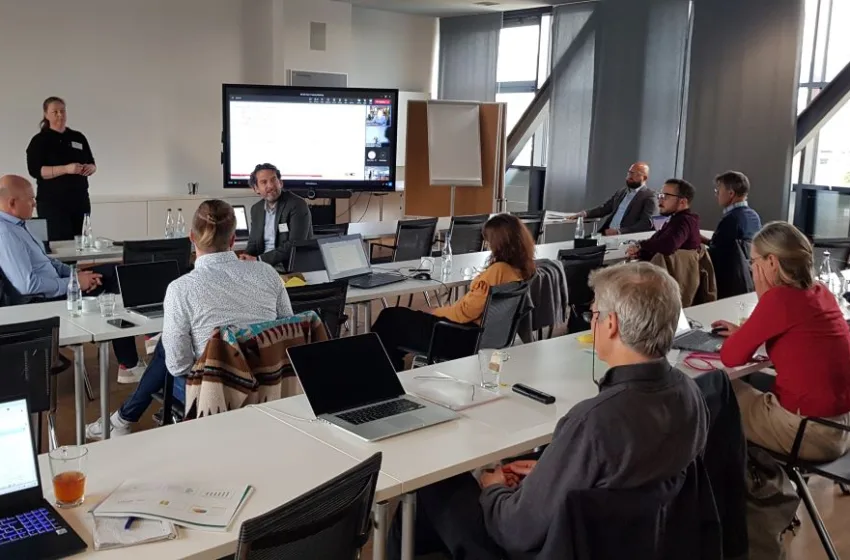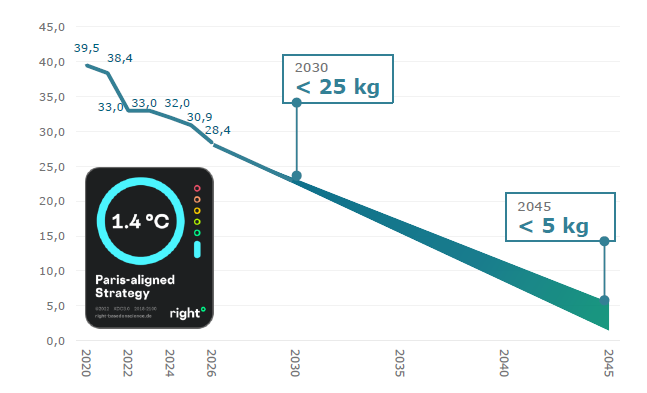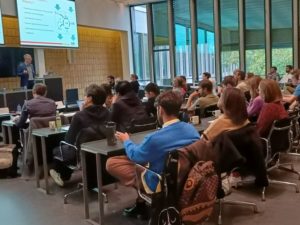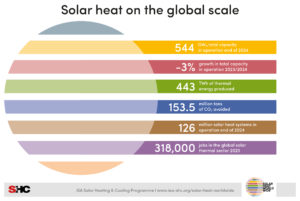Facilitating the private sector on the way to climate neutrality
March 18, 2024
The IEA Solar Heating and Cooling Programme wants to help industries and associations identify their environmental footprint. Life Cycle Assessment (LCA) is a suitable method to compile the environmental impacts of a product throughout its life cycle. The newly started IEA SHC Task 71 on Life Cycle and Cost Assessment for Heating and Cooling Technologies decided to get partners from industrial associations involved in the discussion. Janne Dragsted, Associate Professor at the Technical University of Denmark, moderated the first industry workshop in October 2023 in Germany, which was hosted by the institute Fraunhofer ISE (see photo). The workshop revealed a need for a standardised and simplified LCA approach for both energy demand and supply.
Photo: Task 71
“Companies need easy-to-use LCA tools to develop products that are both economically and ecologically attractive and sustainable. The participants also expressed the wish to link the input in LCA to existing standard test results and databases,” summarized Dragsted from Task’s first industry workshop in October 2023.
Dragsted looks back at 17 years of research activities, among them improving solar thermal products. Therefore, levelized cost of heat (LCOH) calculations for systems had a strong focus in her work. “But LCOH should not stand alone. In the future, LCA will also be very important in connection with the green transition of society,” Dragsted made clear. “This is to make sure that the solutions that are applied will be sustainable ecologically and not only sustainable from an economic point of view.”
Carbon footprint regulations vary from country to country
IEA SHC Task 71 first focused on receiving an overview of specific regulations related to product emission standards and disposal and recycling regulations in selected countries. It became clear that regulations and framework conditions are very different in different countries and regions, as well as the typically used solar thermal technologies, so it becomes clear that there will be no “one solution fits all” for LCA calculations globally.
However, Task participants from the October workshop expect top-down requirements from the European Commission soon. And see their role as supporting the medium-sized solar thermal industry in carrying out the LCA for their products. Existing databases that have already defined a carbon footprint for many materials and processes can help here. In addition, standardized procedures help determine solar yields over the lifespan, such as those typical for Solar Keymark certification.
Europe in the Environmental Footprint transition phase
“In my opinion, the EU is making efforts to develop and implement new regulations to include CO2 emissions from products and services to combat climate change,” said Silvia Guillen Lambea, a researcher at the University of Zaragoza in Spain and one of the key researchers in Task 71. The specific EU regulations are known as the Product Environmental Footprint (PEF) and Organization Environmental Footprint (OEF) methods.
In the recommendations from December 2021, during the pilot phase, the European Commission already made clear that PEF and OEF will be based on Life Cycle Assessment (LCA). In the FAQ, the EU Commission further sets the frame for LCA: “The life cycle includes the extraction, transportation, processing, use, and disposal (or reuse/ recycling). This includes both direct impacts (e.g., impacts on the production site, impacts of transport vehicles controlled by the company) and indirect impacts (e.g., occurring in the supply chain, at extraction, if the company does not control these activities occurring in the use stage).”
“The PEF and OEF methods cover a wide range of sectors. However, they are still in a transition phase and there is little or nothing regarding product group ‘Energy production and distribution’ so there is still a lot of work to be done”, concluded Guillén. The EU DG Environment established a sub-group of experts titled Environmental Footprint transition phase to provide advice and expertise to the Commission. One objective is the development of new PEF and OEF methods.
Facilitating the private sector on the way to climate neutrality
The industry workshops moderated by Dragsted as part of Task 71 aim to exchange ideas with large private-sector players who are already on the path to climate neutrality. In October, the focus was on the housing industry. Yakup Kapa from the Energy Innovation Department of the German Vonovia housing association was one of the speakers. He presented the company’s CO2 targets, which were set in Climate Path 2045 (see graphic below). As an interim goal, the company, with over 500,000 apartments, wants to reduce the carbon intensity to 25 kg CO2 equivalents per square meter of rental area by 2030. Vonovia intends to use a wide variety of measures: energy efficient refurbishment, replacing conventional heating units with hybrid systems, heat pumps, and carbon-free district heating networks. “It will be important to have resourceful stakeholders like the housing industry active in the Task so that the Task results will have an impact,” said Dragsted.
Climate Path 2024 of the German housing association Vonovia with measurable interim targets. The graph shows carbon intensity in kg CO2 equivalent per square metre of rented area per year. Source: Vonovia
Websites of organisations mentioned in this news article:
IEA SHC Programme: https://www.iea-shc.org/
IEA SHC Task 71: https://task71.iea-shc.org/
Technical University of Denmark: https://www.dtu.dk/english
University of Zaragoza: https://www.unizar.es/information-institution/name-and-address
Vonovia: https://www.vonovia.de/en



